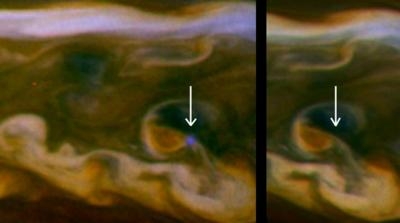Sun, Jul 22, 2012
First Visible Lightning Display On The Gas Giant
Saturn was playing the lightning storm blues. NASA's Cassini spacecraft has captured images of last year's storm on Saturn, the largest storm seen up-close at the planet, with bluish spots in the middle of swirling clouds. Those bluish spots indicate flashes of lightning and mark the first time scientists have detected lightning in visible wavelengths on the side of Saturn illuminated by the sun.

"We didn't think we'd see lightning on Saturn's day side - only its night side," said Ulyana Dyudina, a Cassini imaging team associate based at the California Institute of Technology in Pasadena. "The fact that Cassini was able to detect the lightning means that it was very intense."
The storm occurred last year. The lightning flashes appear brightest in the blue filter of Cassini's imaging camera on March 6, 2011. Scientists aggressively heightened the blue tint of the image to determine its size and location. Scientists are still analyzing why the blue filter catches the lightning. It might be that the lightning really is blue, or it might be that the short exposure of the camera in the blue filter makes the short-lived lightning easier to see.
What scientists do know is that the intensity of the flash is comparable to the strongest flashes on Earth. The visible energy alone is estimated to be about 3 billion watts lasting for one second. The flash is approximately 100 miles (200 kilometers) in diameter when it exits the tops of the clouds. From this, scientists deduce that the lightning bolts originate in the clouds deeper down in Saturn's atmosphere where water droplets freeze. This is analogous to where lightning is created in Earth's atmosphere.

In composite images that show the band of the storm wrapping all the way around Saturn, scientists have seen multiple flashes. In one composite image, they recorded five flashes, and in another, three flashes.
"As summer storm season descends upon Earth's northern latitudes, Cassini provides us a great opportunity to see how weather plays out at different places in our solar system," said Linda Spilker, Cassini project scientist, based at NASA's Jet Propulsion Laboratory, Pasadena, Calif. "Saturn's atmosphere has been changing over the eight years Cassini has been at Saturn, and we can't wait to see what happens next."
The Cassini-Huygens mission is a cooperative project of NASA, the European Space Agency and the Italian Space Agency.
(Images provided by NASA)
More News
Option Approach An approach requested and conducted by a pilot which will result in either a touch-and-go, missed approach, low approach, stop-and-go, or full stop landing. Pilots >[...]
"Emirates is already the world's largest Boeing 777 operator, and we are expanding our commitment to the program today with additional orders for 65 Boeing 777-9s. This is a long-t>[...]
(Pilot) Reported That There Was A Sudden And Violent Vibration Throughout The Airplane That Lasted Several Seconds Analysis: The pilot was returning to his home airport at an altit>[...]
“This recognition was evident during the TBMOPA Annual Convention, where owners and operators clearly expressed their satisfaction with our focus on customer service, and enc>[...]
Overhead Maneuver A series of predetermined maneuvers prescribed for aircraft (often in formation) for entry into the visual flight rules (VFR) traffic pattern and to proceed to a >[...]
 ANN's Daily Aero-Term (11.19.25): Option Approach
ANN's Daily Aero-Term (11.19.25): Option Approach Aero-News: Quote of the Day (11.19.25)
Aero-News: Quote of the Day (11.19.25) NTSB Final Report: Sting Sport TL-2000
NTSB Final Report: Sting Sport TL-2000 Aero-News: Quote of the Day (11.20.25)
Aero-News: Quote of the Day (11.20.25) ANN's Daily Aero-Term (11.20.25): Overhead Maneuver
ANN's Daily Aero-Term (11.20.25): Overhead Maneuver




